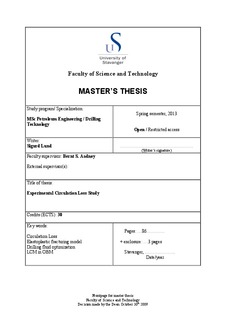| dc.description.abstract | Circulation
losses
could
occur
during
any
operation
that
involves
pumping
into
a
well.
As
of
today,
it
is
recognized
as
one
of
the
most
costly
drilling
problems.
In
some
situation
it
might
be
hard
to
stop,
and
usually
takes
precious
rig
time
to
deal
with
the
problem.
In
order
to
mitigate
the
risk
of
circulation
loss
solid
particles
are
used
in
the
active
drilling
fluid,
known
as
lost
circulation
materials
(LCM).
These
materials
have
a
tendency
to
increase
the
fracture
gradient
of
the
well.
Circulation
losses
occur
in
different
ways,
however,
the
type
of
loss
that
is
treatable
with
LCM
are
those
related
to
fractures
in
the
wellbore
wall.
LCMs
in
the
active
drilling
fluid
will
create
bridges
at
the
fractures;
seal
them
off
and
stop/reduce
the
losses.
Numerous
of
studies
have
been
conducted
for
water-‐based
drilling
fluids,
but
not
so
many
on
oil
based
fluids.
One
of
the
big
differences
between
water
and
oil
based
fluids
is
that
the
friction
between
the
LCM
particles
tend
to
be
less
for
oil
based
fluids
opposed
to
water
based
fluids.
Due
to
this
reason,
the
bridges
created
with
an
oil-‐based
fluid
are,
somewhat,
more
unstable
than
bridges
formed
by
a
water
based
fluids.
Experiments
in
this
thesis
are
divided
into
two
parts.
Part
I
attacks
the
problem
of
finding
a
suitable
particle
size
distribution
(PSD)
for
bridging.
A
theoretical
PSD
was
proposed,
but
test
results
showed
that
the
theoretical
PSD
was
not
very
suitable
for
bridging
purposes.
However,
an
interesting
observation
was
made.
As
the
concentration
of
smaller
particles
increases,
the
fluid
seemed
to
perform
better
in
terms
of
bridging.
The
bigger
particles
form
some
sort
of
a
framework
at
the
fracture
mouth,
whereas
the
smaller
particles
fills
the
voids
between
the
bigger
particles.
This
indicates
that
smaller
particles
are
also
important
in
order
to
achieve
good
bridging
properties.
The
bridging
properties
of
four
different
materials
are
tested
as
LCM
in
oil
based
drilling
fluid
in
part
II
of
the
experimental
part
of
this
work.
CaCO3,
LC-‐Lube,
Feldspar
and
Quartz
were
tested
in
a
bridge
apparatus.
A
couple
of
different
observations
were
made.
Firstly,
CaCO3
mixed
with
LC-‐Lube
(Graphite)
has
shown
to
be
suitable
for
creating
bridges
in
water-‐based
systems.
In
this
study,
CaCO3
and
LC-‐Lube
did
not
show
promising
results,
not
separately
or
in
a
mix.
On
the
other
hand,
Quartz
and
Feldspar
had
good
results,
and
was
able
to
withstand
a
high
average
pressure
for
a
wide
spectrum
of
fracture
openings.
This
was
the
case
even
for
reasonably
small
concentration
of
the
materials
mixed
in
the
drilling
fluid.
Both
of
these
materials
had
good
bridging
capabilities
with
a
concentration
of
39kg/m3.
At
a
fracture
opening
of
500-‐micron,
Quartz
proved
to
be
400%
better
in
terms
of
average
test
pressure
than
CaCO3.
Generally,
particles
at
the
upper
part
of
Mohs
scale
of
hardness
performed
better
than
particles
at
the
lower
part
of
Mohs
scale.
This
observation
is
in
line
with
the
recently
developed
Elastoplastic
fracture
model
from
the
University
of
Stavanger.
Synergy
between
the
materials
was
also
tested.
No
good
combinations
were
found.
All
materials
acted
better
as
LCM
separately
opposed
to
being
in
a
mixture
with
any
of
the
other
materials. | no_NO |
